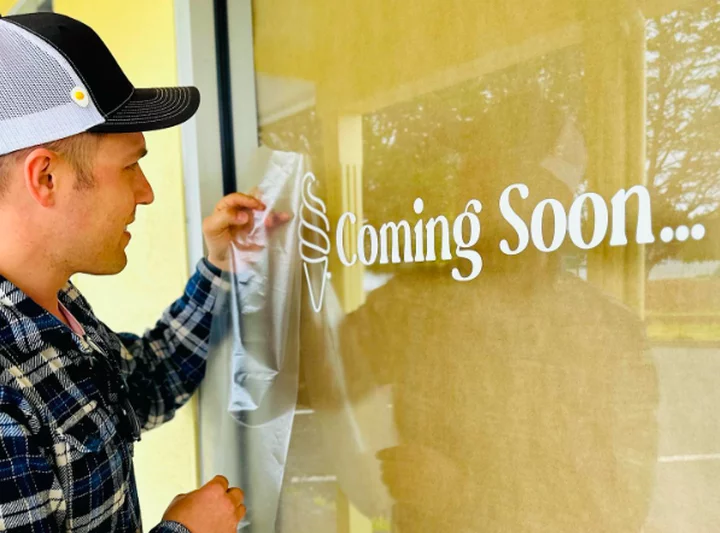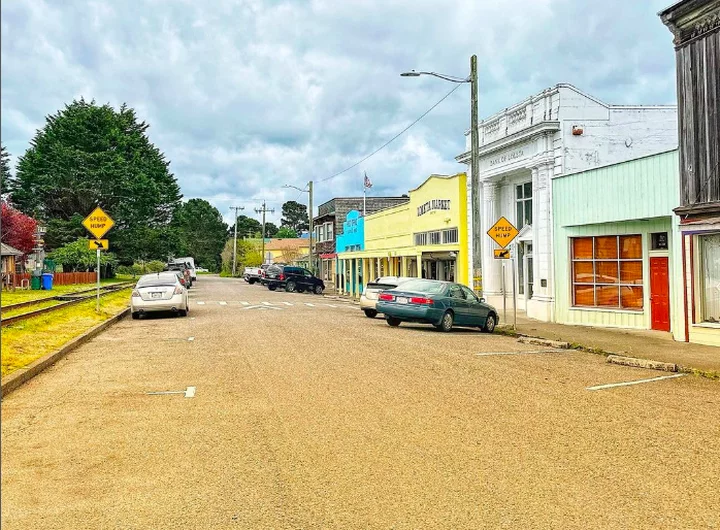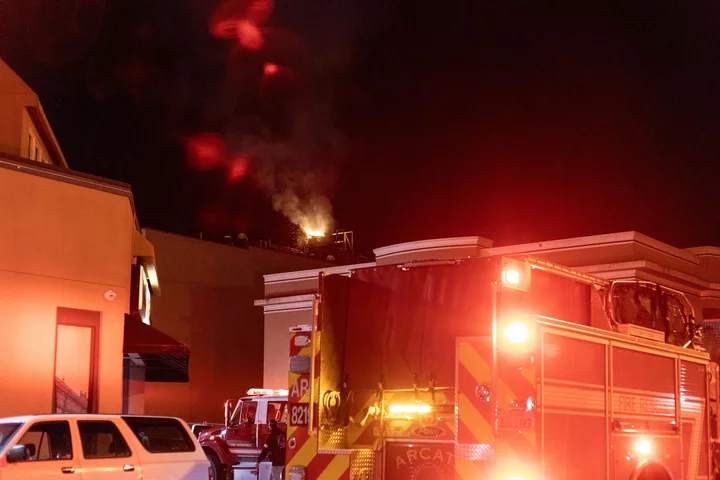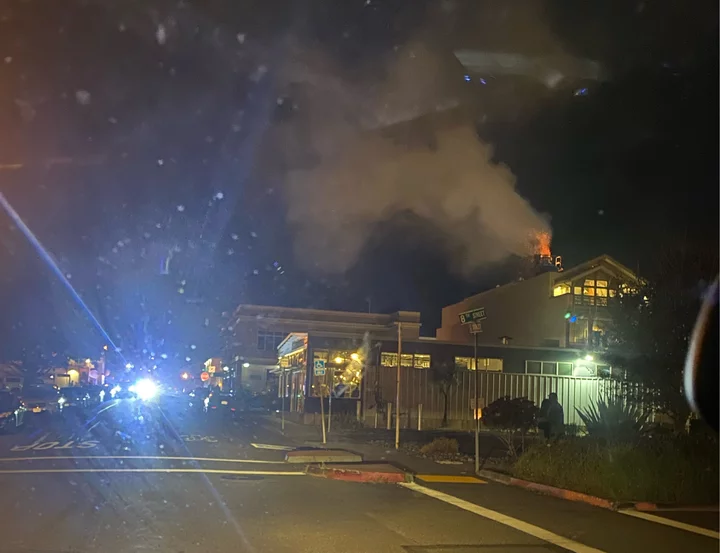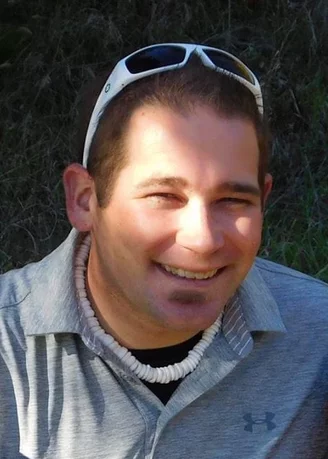The Foggy Bottoms Boys Give the Scoop on the Local Farm’s Soon-to-Open Loleta Ice Cream Shop
Stephanie McGeary / Friday, May 5, 2023 @ 2:09 p.m. / Business , Community , Food
Thomas Nicholson Stratton placing the window sticker on the new, no-longer secret ice cream shop location | Images from Foggy Bottoms Boys Instagram
###
If you follow the Foggy Bottoms Boys on social media – it’s the beloved Ferndale-based farm headed by self-described “fabulously gay farmers” Cody and Thomas Nicholson Stratton – then you already know that the dynamic duo recently announced plans to open an ice cream shop, where they will be serving artisanal soft-serve and classic ice cream made from the milk of their own Jersey cows.
Though the Boys have been intentionally tight-lipped about the name and location of their newest venture, on Friday morning Thomas gave the Outpost the full scoop. In honor of the cows from which their milk comes, the new ice cream will be called Jersey Scoop and, as many people already guessed on Facebook and Instagram and maybe if they’ve noticed the “coming soon” sign already on the window, the shop will take over the space previously occupied by the Loleta Bakery.
“It’s really exciting for us,” Nicholson Stratton told the Outpost, adding that the space, which has a somewhat controversial history, has been vacant for a long time. With the bakery’s closure, plus the more recent closure of the once very popular Loleta Cheese Factory, Loleta has been in an economic slump and Foggy Bottoms is hoping to help breathe life back into the town’s Main Street. “We absolutely believe in the concept of not just us thriving, but multiple other businesses coming in and thriving.”
The space will basically be Foggy Bottoms Boys’ new headquarters, Nicholson Stratton said, with a main office where people can place orders for dairy and meat products and book tours of the farm. It will also have a kitchen, industrial freezers to hold their products, and the ice cream shop. The shop will include a classic ice cream-dipping cabinet with rotating, seasonal flavors, and — possibly even more exciting — a soft-serve machine, which will include one featured flavor that changes weekly. In addition to the ice cream, the shop will serve some other light fare, including sandwiches, soups and pastries from Ferndale bakery Patches’ Pastries. You’ll also be able to buy pints of the artisanal ice cream to take with you.
Jersey Scoop ice cream will also be available for purchase in local grocery stores. At least to start, Nicholson Stratton said, the company will release two flavors for the stores – one will be a rich and creamy classic vanilla, and the other will be a new “fun flavor.” But the name and flavor of the new ice cream is something Nicholson Stratton was not willing to share yet.
“That info is for sure under wraps,” he said. Nicholson Stratton’s other half, Cody, posted a social media contest asking for flavor name suggestions. They didn’t end up using any of the names, exactly, Nicholson Stratton said, but they did base the name on one of the suggestions.
As far as when this will all happen, Nicholson Stratton said the company still has to go through some inspection processes and is shooting to have the ice cream shop open by mid-summer. Because the process for being able to sell products in grocery stores is a little more arduous, he said, it will probably take a bit longer for the ice cream pints to hit shelves.
If you are just so excited to taste the creamy treats of Jersey Scoop that you can’t wait until then, Nicholson Stratton said that the farmers plan to have their ice cream available at the Arcata Farmers Market before they have them anyplace else. The hope is to have ice cream pints available for purchase at their Farmers’ Market booth within the next month.
The other great way to help ensure the ice cream business gets going as quickly as possible is to help support the Foggy Bottoms Boys by purchasing their products (if you don’t already).
“What will help us get there [is] if anybody wants to go to Foggy Bottoms Boys and order and pick up at the Farmers’ Market or order and we can deliver to you on Sundays; that would be great,” Nicholson Stratton said.
###
PREVIOUSLY:
- (AUDIO) HUMBOLDT HOLDING UP: Getting to Know the Foggy Bottoms Boys, Gay Ferndale Farmers and Social Media Stars
- Ferndale’s Foggy Bottoms Boys Honored as Climate Smart Farmers of the Year
Loleta’s Main Street. The yellow building will hold Foggy Bottom Boys’ new hub.
BOOKED
Today: 11 felonies, 16 misdemeanors, 0 infractions
JUDGED
Humboldt County Superior Court Calendar: Today
CHP REPORTS
Pine Grove Rd (HM office): Trfc Collision-No Inj
ELSEWHERE
County of Humboldt Meetings: Fish & Game Advisory Commission Agenda - Regular Meeting
Governor’s Office: TIME’s Person of the Year was Made in California
Governor’s Office: Governor Newsom visits LA recovery efforts in Altadena and the Palisades, views homes set to be completed soon
RHBB: Woman Extricated After Solo Crash Into Tree on State Route 3 Near Hayfork
Fire at Arcata’s Campground Restaurant Last Night Contained With Minimal Structural Damage, Fire District Says
Hank Sims / Friday, May 5, 2023 @ 10:37 a.m. / Fire
Photo: Tahvo Stephan.
Last night the ventilation system at the upscale off-Plaza restaurant Campground caught fire, sending flames and smoke like a beacon.
The images were spectacular, but the damage was not as bad as it might have been. Chris Emmons, assistant chief of the Arcata Fire District, tells the Outpost this morning that the built-in sprinkler systems performed admirably in containing the fire, and the staff of the restaurant were able to safely evacuate themselves and customers.
“As spectacular as it looked, it was actually lucky, for lack of a better term, that it didn’t spread,” Emmons said.
In short: Not much damage to the building, though of course restaurant operations will be affected for a while.
Emmons said that it will have a more complete rundown of the fire and a tally of the damage in a press release today. We’ll update with that when they send it.
###
UPDATE: And here it is:
On 5/4/2023 at 9:45 P.M. a unit from Arcata Fire was dispatched to a local alarm at Campground restaurant in Arcata. While in route, the Fortuna Emergency Command Center upgraded the response to a full commercial structure fire dispatch.
Firefighters arrived to a three-story building with a restaurant on the ground floor and apartments on the upper floors. The first engine that arrived on scene found smoke and flames coming from the ventilation fan on the roof and fire in the kitchen area of the restaurant. The fire was found to have traveled from the kitchen area to the roof vent.
Additional Arcata units arrived and began evacuating the remainder of the structure and looking for extension of the fire throughout the building. The restaurant staff did an excellent job of evacuating patrons from the restaurant before firefighters arrived on scene. Mutual aid resources arrived on scene and assisted with all operations.
The fire was reported to be accidental due to the hood ventilation system having a buildup of grease that had ignited. The extinguishing system held the fire in check and slowed the spread.
Mutual aid resources were released to provide coverage of the Arcata Fire Protection District while Arcata units remained engaged in the incident.Estimated damages come to $100,000.
Upon completion of the incident, all units were returned to their respective jurisdictions. Thanks go out to Humboldt Bay Fire, Blue Lake Vol. Fire, Fieldbrook Vol. Fire, Westhaven Vol. Fire, Samoa Vol. Fire and Kneeland Vol. Fire for providing mutual aid.
If you have questions, please contact the Arcata Fire Protection District at 707-825-2000.
Photo: The Pabst Boys.
Photo: Tahvo Stephan.
OBITUARY: David James Renfer, 1985-2023
LoCO Staff / Friday, May 5, 2023 @ 6:56 a.m. / Obits
David James Renfer, a beloved member of the community and a dedicated father, volunteer and golfer, passed away unexpectedly on April 30, 2023. Although we are heartbroken at this tremendous loss, we take comfort in knowing David is with the Lord he loved so deeply. He was born in Portland, Oregon on July 10, 1985. He was 37 years old.
David’s greatest love was being a father to his two boys, Connor and Kasey. Fatherhood changed David’s life and he truly found his identity in being a loving dad. He embraced every moment and opportunity to be there for Connor and Kasey, whether it was grabbing his glove to play catch at a moment’s notice, or never missing a single practice, game or recital. David was especially known for being at least 30 minutes early every day for after-school pick up so the boys never had to wait. He demonstrated his deep love for his boys through words and actions every day. The boys were his world.
David grew up with a love for sports, especially golf and tennis. Playing in tournaments from a young age, he became a highly skilled golfer and famously long-driver off the tee. Some of his proudest accomplishments were reaching the state finals his senior year and the hole-in-one he hit during a junior high match at Quail Lodge Golf Club. After graduation, he continued his passion for the sport by playing regular weekly golf competitions at Eureka Municipal Golf Course.
David cherished the opportunity to pass on his love for sports to others through coaching. He volunteered as a coach and mentor to teach young players the fundamentals of baseball, basketball and soccer. His enthusiastic and encouraging coaching style made him a beloved figure among the youth sports community.
Recently, David found a new passion as a youth group leader at his local church, Faith Center. He enjoyed working with young people, sharing his love for the Lord, and making a positive impact on their lives. David’s dedication and enthusiasm for his work inspired many of the youth in his group, and he quickly became a beloved mentor.
David will be remembered for his infectious smile, his youthful enthusiasm, and his brightly-colored golf shirts. His love for his family and friends was unwavering. David had an incredible ability to comfort others through his strong faith in the Lord.
He leaves behind his wife Natalie, his two sons, Connor and Kasey, his mother Kimberly Walker, father Len Renfer, sister Jenny Kamnikar (Shaun), niece and nephew Hailey and Walker Kamnikar, brother Danny Renfer, mother-in-law Vicki Casey, sister-in-laws Valerie Canfield and Stephanie Goodwin (Beau), nieces and nephews Ella and Cade Canfield and Carter and Amelia Goodwin, grandparents Jim and Bonnie Walker and Dorothy Renfer. He also leaves behind a large extended family and community. David was preceded in death by grandparents Leonard Renfer Jr. and Linda Renfer and Father-in-law Ben Casey.
A memorial service will be held on May 7th, 2023 at 3:00 pm, at the Faith Center Church of Eureka. In lieu of flowers, the family asks that donations be made in his memory to Redwood Fields to benefit youth sports programs. Donations may be sent in the form of check to P.O. Box 327, Cutten, CA 95534.
David, we love you and miss you dearly. We will cherish our memories until we meet again.
###
The obituary above was submitted on behalf of David Renfer’s loved ones. The Lost Coast Outpost runs obituaries of Humboldt County residents at no charge. See guidelines here. Email news@lostcoastoutpost.com.
OBITUARY: David Joseph Lindstrom, 1932-2023
LoCO Staff / Friday, May 5, 2023 @ 6:56 a.m. / Obits
David Joseph Lindstrom
February
9, 1932 – April 6, 2023
Dave Lindstrom passed away on April 6, 2023 after a long battle with Parkinson’s Disease. He was 91 years old.
Dave was born in Eureka on February 9, 1932. He grew up in Fairhaven on the Samoa Peninsula, where most of the Lindstrom family had settled. His first six grades were in one room at the Rolph School, which is now used by the Fairhaven Fire Department. After that, he attended Eureka Jr. and Sr. High School, where he ran track and played the trombone in the band.
He became interested in flying as a young boy, when the US Navy flew in several planes for an airshow at the Blimp Base, located near the current Fairhaven airport and dragstrip. At 14 years old, and to the surprise of his parents, he started flying lessons with Al Camilli. After some four hours of dual flight, he soloed and received his student license.
After graduating from Eureka high School in 1949, he took jobs at the local mills while going to Humboldt State College. After a year and a half at HSC, the Korean War broke out and he joined the Navy in the Aviation Division. After attending several schools from Jacksonville, Florida to Barbers Point, Hawaii, he received his “combat air crew” wings and was sent to an anti-submarine squadron located at Los Alamitos Navy Base. After training with submarines off San Diego and qualifying on “jeep” carriers, they made their first six-month tour off Korea. He said the most exciting times were getting shot off the 590-ft. carrier by the catapult. The carrier was the USS Bataan, which was said to have the fastest catapult in the Navy at the time, launching the planes to 90 knots, or over 100 mph, in 70 feet. The trick was getting back onto the carrier after a four-hour flight in the dark, which always made for “exciting” times.
After four years in the Navy, he returned home to resume working as an electrician. He spent his spare time building drag racing cars in his parent’s garage, one of which was the first “slingshot” dragster in Humboldt County. He went on to win multiple championships at the Samoa Drag Strip. His racing was put on hold when he married Deanne Walsh and began raising a family.
He continued his love of hunting throughout his life, with his best memories being times spent with his family and friends at the family hunting camp near Bug Creek Butte, becoming known locally as “Lindstrom Rock,” where his grandfather and father had hunted since 1917. He also made many out-of-state hunting trips with his family and friends, including hunting trips for mule deer, elk, caribou, and antelope.
Dave was also an avid fisherman. He especially loved salmon fishing in the local ocean waters. He built a cabin cruiser in 1963 in his parents’ garage and named her the “Dawn Marie” after his daughter. He was able to enjoy many salmon fishing trips with family and friends over the years.
After working as an electrician for about 14 years upon returning home from the Navy, he started his own electric motor repair shop, Arcata Electric Motor Service, and ran it until his retirement in 2004.
In the mid 1970s, he was able to resume his love of flying. He first bought a 1947 Stinson taildragger, then progressed to a Cessna 206 and later a Cessna 210. He enjoyed flying whenever he had the chance, including vacations as far away as Florida, flying to Fort Bragg to go diving for abalone, and to Baja, Mexico for fishing trips. He eventually sold the planes and bought a commercial fishing boat, naming her the “Josie L” after his mother, which his son Dale still operates, mainly for crab fishing in the winter months. He later bought a second and larger boat, naming her after his granddaughter Molly, which was used for offshore albacore fishing for a few years.
Dave is survived by his children, Dale Lindstrom, Dennis Lindstrom and Dawn Lindstrom, Jami Sanchez, Lani Bomshtein, stepson Jason Rainwater, his 7 grandchildren, and 14 great grandchildren. He is preceded in death by his parents, Walter and Josephine Lindstrom, his grandson Walter Lindstrom, and many lifelong friends, including Doug Lewallen and Bud Peterson. The family would like to express our gratitude to the Veterans Administration and Hospice of Humboldt for the wonderful care they gave our dad throughout the last years of his life.
A celebration of life will be held on Saturday, May 13 at 2 p.m., at the Veteran’s Hall in Arcata. All friends and family are welcome to attend and share stories and memories of Dave. Refreshments will be served.
###
The obituary above was submitted on behalf of Dave Lindstrom’s loved ones. The Lost Coast Outpost runs obituaries of Humboldt County residents at no charge. See guidelines here. Email news@lostcoastoutpost.com.
OBITUARY: Duane Rickie (Rick) Lewis, 1953-2023
LoCO Staff / Friday, May 5, 2023 @ 6:56 a.m. / Obits
Duane Rickie (Rick) Lewis of Rio Dell passed away March 4, 2023. He
was born to Richard and Roberta Lewis on June 21, 1953, in Arcata. He
was the youngest of five children, having four older brothers and one
older sister.
He graduated from McKinleyville High School, which is also where he met his wife, Teresa Dore. They were married in 1974 and had two daughters. They first raised their girls in Orick, close to Teresa’s parents and their family hometown. On the weekends, they would often drive to McKinleyville for Lewis gatherings, gaining numerous stories that have been told numerous times and will hopefully continue to be. Rick worked for Arcata Redwood for many years. The family moved to Fortuna in 1985 when Rick obtained a position with Pacific Lumber Company.
Our dad was not only our mentor, but our playmate. We looked forward to him coming home every day, especially during the summer months in Orick. He would often take us fishing, teaching us both at young ages to bait a hook and cast, (although I doubt either of us are capable now-unless it’s like riding a bike). Speaking of which, bike riding was a definite past time which we did often together. One of us never learned to use our bike brakes and would crash into the mobile home to stop. He would do damage control to prevent her from being in trouble with our mom. He loved the outdoors, nature and all of the animals in it.
Rick worked at Pacific Lumber Company in many different positions, starting with pulling green chain and ending with loader operator. He received the nickname “Bobber” while pushing logs on the pond. He enjoyed playing softball and basketball on one of the PL company teams each year.
Our dad was a giver. He gave and did for many, including his in-laws in their final years. We have seen many obituaries that say, “they would have taken their shirt off their back for anyone”, and our father is among that category of humans.
He is survived by his children Jackie (Joe) Eldridge, Monica Pitts, his grandchildren Mackenzie Eldridge, Madison Eldridge, and Hallie Pitts, his brothers David (Sue) Lewis, Donald (Karen) Lewis, Dennis (Kathy) Lewis and sister Diane Grimes. He is also survived by many nieces and nephews.
He was preceded in death by his parents Richard and Roberta Lewis, and his wife Teresa (Dore) Lewis.
His ashes will be spread with the love of his life, Teresa. No funeral services will be held.
###
The obituary above was submitted on behalf of Rick Lewis’ loved ones. The Lost Coast Outpost runs obituaries of Humboldt County residents at no charge. See guidelines here. Email news@lostcoastoutpost.com.
OBITUARY: James Troy Snead Jr., 1932-2023
LoCO Staff / Friday, May 5, 2023 @ 6:56 a.m. / Obits
James
(Jim) Troy Snead Jr. passed away at the age of 90 on April 24, 2023
at his home in Eureka.
Jim was born in San Francisco on July 25, 1932. After high school, he enlisted in the National Guard and then the US Air Force. After his honorable discharge from the military, he worked for Western Electric Phone Company for 33 years. He retired from the phone company and a few years later started working at KIEM TV part-time. After his retirement from KIEM TV, he spent time traveling the United States and many different countries including Panama, Canada, Scotland and Morocco. When home he liked to spend his time puttering in his garage, golfing, fishing and camping. He also made a point to attend as many sports events, musical recitals, graduations and more for his grandchildren. He loved that his grandchildren & great grandchildren called him “GGPa.” He was a fan of the San Francisco 49ers and Giants and he watched many games on TV and in-person.
Jim thought of himself as a comedian and was famous in the family for his sayings like “If the rain keeps up, it won’t come down.” If someone asked him how he was feeling, his answer would always be “with my fingers.”
One of the highlights of his life was being part of one of the Honor Flights to Washington DC. Above all else, Jim felt the Lord blessed him with his loving family and friends and never hesitated to tell his family. He gave great hugs and was always ready to help everyone.
Jim’s family wants to extend a special thanks to Hospice and to the doctors and staff at the Veterans Department in Eureka for their amazing help and compassion in the final days of his life.
He is survived by his loving partner, Frances Argo, daughters Dawn Snead & Diane Morrison (Larry), daughter-in-law Debbie Snead, six grandchildren, Rodney Morrison (Becky), Ryan Morrison, Janel Person (Ron), Craig Mitchell Jr., Carrie Snead (Jeff) and Jamison Snead. He is also survived by eight great grandchildren; James Morrison, Seth Morrison, Alan Morrison, Dominic Person, Zaniyah Person, Aurora Mitchell, Jade Mitchell and Neo Rosen-Mitchell. He is also survived by other special people in his life; Fran’s children and grandchildren, Sarah & Pam Rosen-Mitchell and his little doggy companion Mr. Bixby.
Jim was preceded in death by his first wife, Janet Snead & his second wife, Mary Ruth Snead, his sons, James Patrick (Bimbo) Snead and James Troy Snead III, his father James Troy Snead Sr, his mother, Evelyn Snead, his sister, Dorothy Snead and his best friend, Sid Riddle
A celebration of Jim’s life will be announced at a later date via friends, family & Facebook.
###
The obituary above was submitted on behalf of Jim Snead’s loved ones. The Lost Coast Outpost runs obituaries of Humboldt County residents at no charge. See guidelines here. Email news@lostcoastoutpost.com.
OBITUARY: Leroy Rakestraw, 1936-2023
LoCO Staff / Friday, May 5, 2023 @ 6:56 a.m. / Obits
On Sunday, January 22, 2023, Leroy Rakestraw, loving husband, father, and papa of many passed away at the age of 86.
Leroy was born May 18,1936 in Eureka to Harry and Dorothy Rakestraw. He graduated from Eureka High School in Eureka. He had many passions in life. After he joined the Air Force and served his time in Arizona he got married to Betty Scott and they had a child, Pamela.
While he worked as a logger for most of his life, he pursued a college education graduating from Humboldt State College. He taught school for a while, then went back to logging. In 1974 he married his second wife, Cynthia. He then became a stepdad to four children. He then pursued the mission of becoming a Presbyterian minister and he obtained that, ministering at the Presbyterian Church in Orick.
After the children were raised they took up foster parenting. They became foster parents to many children. The ones that held the closest part in their heart were Albert and Barbara Mills, who they cared for as their own children. He also played a big part in the raising of his granddaughter Lacey. He had many hobbies, running and cycling, he participated in various marathons. He was cycling up until his last year of life. His other skills were woodworking, a mechanic and music.
Leroy was preceded in death by his wife Cynthia, his brother Herbert Brooks, his parents Harry and Dorothy Rakestaw, his granddaughter Shannon Ordonez, and his grandson Nicholas Sellars.
Leroy is survived by his brother Bob Rakestraw (Barbara), his sister in law Joanne Lewis (Richard),his brother in law John Panter, and numerous nieces and nephews. Leroy is survived by his daughter Pamela Rakestraw, His stepchildren, Lura Dickey (Stanley), Debbie Williams, Bobbie Williams (Allen)and Patrick Williams.
Leroy had many grandchildren: Rolland and Audrey, Ryan and Michaela, Eric and Kelly Dickey, Roseanne and Jessie Ordonez, Christine and Angela Williams, John, Jeff and Chloe Williams, Shelby and Chris, Lacey Readen, Brannon Hennings, Annabelle Mills, Aiden and Allen Chilcott, and Claudio Mills.
Lots of great grandchildren: Juan, Jasmine, Deborah, and Robert Esconbido, Theresia, Lucas, Natalie, Alexis, Karter,America, Kennedy, Corinne Dickey, Rylynn and Colton Lane, Kai and Kobe Yang,Koen Wolf, Thalia,Cyndi, Alicia, Tino and Cattleya Ordonez, Zachery Crain and Ariana Martinez.
Great-Great-Grandchildren: Camelia, Cartier and Kylo. He was known as Papa by all of his grandchildren.
We will be having a Celebration of Life on May 20, 2023 at Moonstone Beach House, Westhaven,12-3 p.m.
The family would like to extend a very special thank you to Wier’s Mortuary.
###
The obituary above was submitted on behalf of Leroy Rakestraw’s loved ones. The Lost Coast Outpost runs obituaries of Humboldt County residents at no charge. See guidelines here. Email news@lostcoastoutpost.com.

